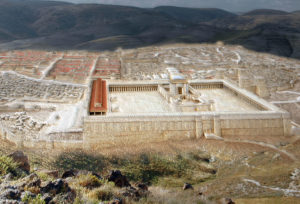LIKE THE ANNOUNCER for a starring act, John wasn’t on stage long. His ministry may have lasted just a year or so. But it was long enough to draw a crowd—and then to point the people to Jesus.
Luke implies that John got his first message from God “In the fifteenth year of the reign of Emperor Tiberius” ([biblegateway passage=”Luke 3:1″]). That’s about AD 28 or 29. John died before Jesus, whose crucifixion is estimated anywhere from AD 30-33.
Yet in that short time, John managed to draw enough attention that he got himself executed, and written up in a Roman history book published during his own century:
“Herod [Antipas, ruler of Galilee] killed John….who was called the Baptist….a good man who commanded the Jews to exercise virtue, both in righteousness to one another and in faithfulness to God.”
Josephus (about AD 37-101)
Antiquities of the Jews
Miracle baby
Like Jesus, John got an angelic introduction. Gabriel appeared to John’s father, Zechariah, a Jerusalem temple priest.
Gabriel told Zechariah, “Your wife, Elizabeth, will give you a son, and you are to name him John….And he will turn many Israelites to the Lord their God” ([biblegateway passage=”Luke 1:13, 16″]).
Six months into Elizabeth’s pregnancy, Gabriel appeared to a Nazareth woman named Mary. He told her she would give birth to Jesus—and that her relative Elizabeth was already pregnant. Mary traveled to the home of Zechariah and Elizabeth, near Jerusalem. She stayed with them for about three months—apparently long enough to see John’s birth and dedication.
Prophet instead of a priest
Born into a priest’s family, John probably could have served as a temple priest. Well paid. Well respected.
Instead, he became a prophet and a preacher. Instead of dressing for success, he dressed cheaply and ate cheaper: “John wore clothes made out of camel’s hair. He had a leather belt around his waist. And he ate locusts and wild honey” ([biblegateway passage=”Mark 1:6 “]).
He looked and sounded like a prophet, in a day when prophets were little more than nostalgic characters from Jewish history. People seemed to love that retro in him.
His message resonated, too. After a century of Roman occupation, Jews were looking for God’s Messiah to finally come. John said it was about to happen. Quoting ancient prophecies such as “Prepare the way for the LORD’s coming!” ([biblegateway passage=”Luke 3:4″]), John urged people to repent, and be ready when the Lord arrives.
John initiated the ritual of baptism, apparently as a vivid symbol of spiritual cleansing.
Jesus launched his own ministry by having John baptize him, though John resisted: “I am the one who needs to be baptized by you” ([biblegateway passage=”Matthew 3:14”]).
John beheaded
Calling the first lady of Galilee a pervert is pretty much what did John in.
He had criticized the marriage of Herod Antipas, Galilee’s ruler, calling it incest. By Jewish law, it was. Herod’s wife, Herodias, had divorced his brother to marry him. The broken law: “Do not have sexual relations with your brother’s wife” ([biblegateway passage=”Leviticus 18:16″]).
Herodias’ daughter danced for Herod at his birthday party. Delighted at what he saw, Herod offered her anything she wanted. She consulted her mother, who requested John’s head on a platter ([biblegateway passage=”Matthew 14:1-12″]).
From Illustrated Bible Dictionary, by Stephen M. Miller,
published by Barbour Publishing, Inc. Used by permission.
Random book winner this week
Carmen Perreira.
I give away one free book a week to a randomly selected subscriber to my free blog and quarterly newsletter.
Carmen is random this week.


I know I sound like a rah-rah man, but I have given many of these “Illustrated Bible Dictionaries” away (and not just the ones I won for asking questions Lol). They are packed with tons of information on the Bible and Christianity, they make interesting reading, and perfect for non-Christians or those who aren’t religious. I have had more compliments from friends who started reading this book who would not normally pick up a Bible. I have enjoyed this book myself — many times.
Wayne, I’d put you on the payroll if I had one. Thank you.